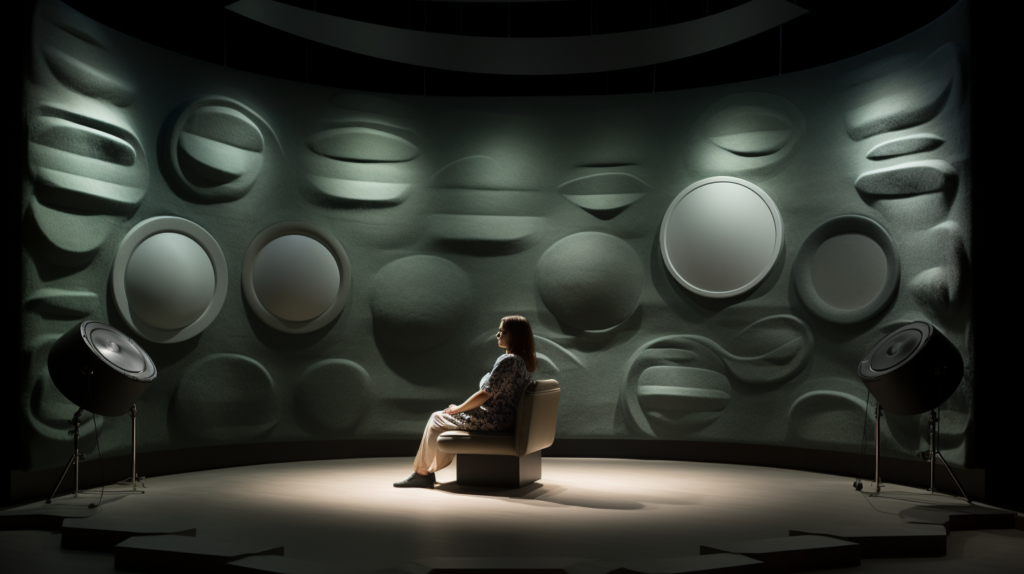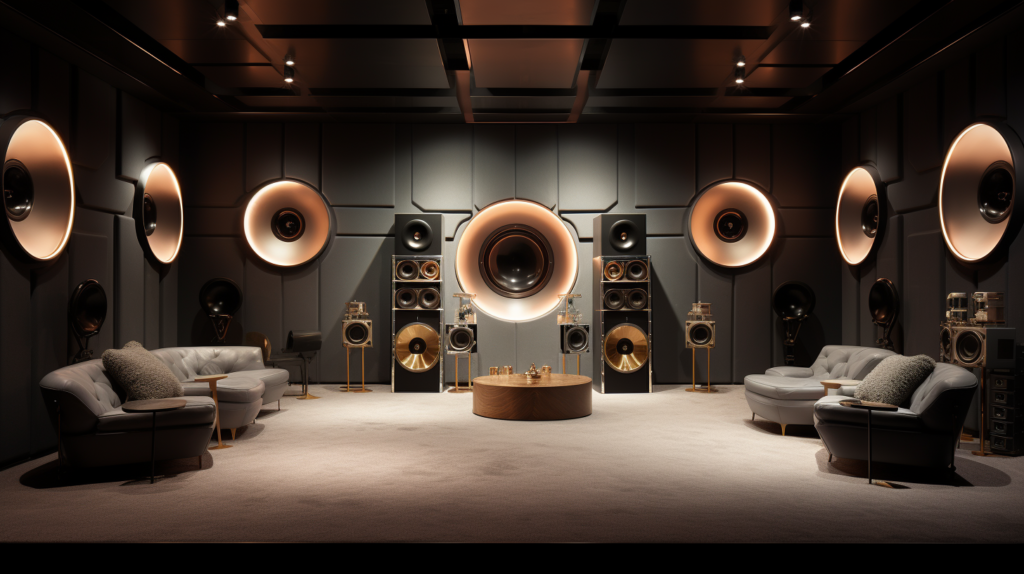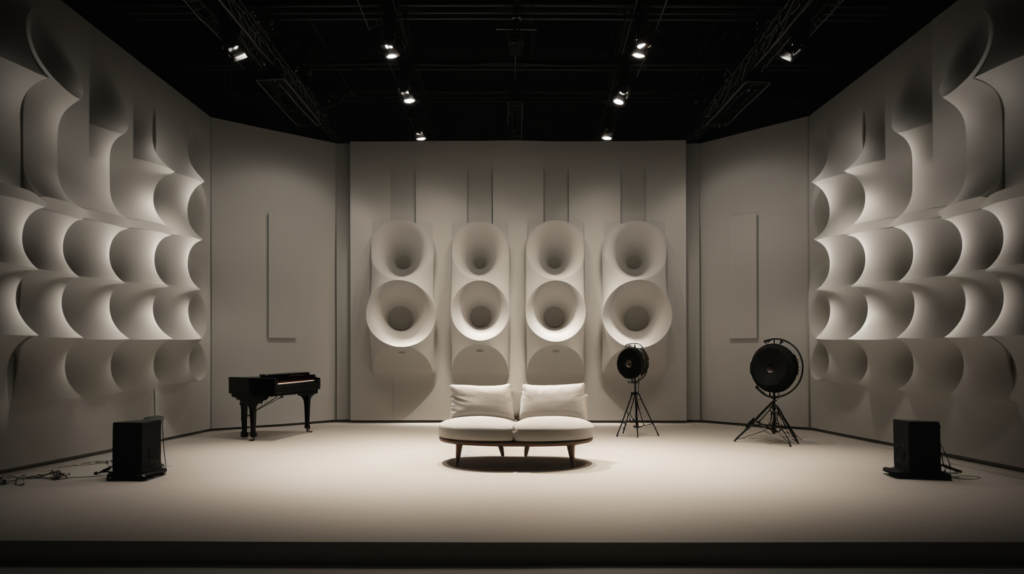Have you ever walked into a room and felt like you’ve stepped into a live recording of your favorite podcast, only to realize it’s the room’s acoustics playing tricks on you?
Whether you’re a sound engineer, an architect, or simply a homeowner interested in improving the sound quality of your space, understanding the ratings of acoustic panels is crucial.
These ratings, including NRC, SAC, and STC, are the “nutrition labels” for acoustic materials, guiding you through their capabilities and limitations.
Ready to become an informed consumer in the world of acoustics? Let’s dive into the ins and outs of these essential ratings.
Why Do Acoustic Panel Ratings Matter?

When it comes to selecting the right acoustic panels, their ratings serve as crucial benchmarks.
These are not just numbers; they are standardized measures obtained through meticulous scientific testing.
The ratings offer a level playing field for evaluating the performance of a wide range of acoustic materials, from foam to fabric-wrapped to polyester acoustic panels.
Understanding the significance of these ratings is essential, regardless of whether you’re a sound engineer, an architect, or just a homeowner looking to improve your living space.
These ratings give you the tools to differentiate between products that may look similar but have vastly different capabilities when it comes to sound absorption and control.
Imagine you’re faced with two seemingly identical acoustic panels; how do you know which one will better meet your needs? This is where ratings like NRC and SAC come in.
They provide an objective, standardized way to assess and compare the effectiveness of different panels.
They guide you in selecting a product that not only meets but exceeds your specific acoustic requirements.
What Is Noise Reduction Coefficient (NRC) and How Is It Measured?

What Is NRC?
The Noise Reduction Coefficient (NRC) is one of the most commonly used metrics for measuring a material’s sound absorption capabilities.
This rating offers a simplified yet effective way to understand how well a particular material will absorb sound energy.
In essence, NRC gives you a snapshot of how “echoey” a room will be when fitted with a specific type of acoustic panel.
The NRC rating is usually expressed as a decimal number between 0 and 1, although it is often converted into a percentage for ease of understanding.
For instance, an NRC rating of 0.8, or 80%, signifies that the acoustic panel in question absorbs 80% of the sound that strikes it.
The remaining 20% will be reflected back into the room or will pass through the material. Understanding this balance is critical when considering the acoustics of a space.
For example, in environments like recording studios or conference rooms, high NRC ratings are essential because they ensure that echoes and background noise are kept to a minimum, improving sound clarity and quality.
How Is NRC Tested?
Determining the NRC rating of a material involves a series of standardized tests that are conducted under controlled conditions.
Specialized acoustic laboratories typically perform these tests.
The material is exposed to various sound frequencies, usually ranging between 250 to 4000 Hz, and its absorption capabilities are measured at each frequency.
After the absorption coefficients at these individual frequencies have been determined, they are averaged to arrive at a single, composite NRC rating.
This average provides a general idea of how effective the material will be at absorbing sound across a broad spectrum of frequencies.
It’s worth noting that because the NRC is an average, it may not fully represent a material’s performance at individual frequencies.
However, it does offer a reliable and straightforward way to gauge a material’s overall sound absorption capabilities.
How Do I Interpret NRC Values?
NRC values offer a quick and easy way to assess the effectiveness of different acoustic panels in absorbing sound.
A high NRC rating indicates excellent sound absorption, making the material ideal for environments where sound clarity is crucial.
Conversely, a low NRC rating would suggest that the material is less effective at absorbing sound and may be more suited for applications where sound reflection or diffusion is desired.
When you encounter an NRC rating, think of it as a valuable tool for making quick comparisons between different types of acoustic panels.
If you are comparing a foam panel with a polyester acoustic panel, for example, a higher NRC rating on one of them would suggest that it is generally more effective at absorbing sound.
This comparative insight makes NRC an invaluable metric for informed decision-making, guiding you toward the best acoustic solution for your specific needs.
What Is Sound Absorption Coefficient (SAC) and How Does It Differ From NRC?

What Is SAC?
The Sound Absorption Coefficient (SAC) is another critical rating system for evaluating the sound absorption qualities of acoustic panels.
While NRC provides a generalized idea of a material’s sound absorption effectiveness, SAC offers a more nuanced and detailed insight.
It breaks down the sound absorption capabilities of a material at specific frequencies, allowing for a more precise understanding of how a material will perform under different acoustic conditions.
The SAC rating is often considered a more advanced metric, particularly useful for specialized settings like recording studios or concert halls.
In these environments, the sound profile is more complex, involving a variety of instruments and voice ranges, each with its own set of frequencies.
The SAC allows you to tailor your acoustic treatment to these specific sounds, thereby optimizing the acoustical properties of the space.
For instance, polyester acoustic panels might have a particular SAC profile that makes them especially effective at absorbing lower frequencies, a feature you can ascertain from a detailed SAC chart.
How Is SAC Tested?
The process for determining the SAC rating of an acoustic panel is generally more complex and detailed than that for NRC.
The tests involve exposing the material to a range of frequencies, often in an anechoic chamber, which is designed to eliminate reflections and other acoustic variables that could interfere with the measurements.
This allows for a more accurate assessment of the material’s sound absorption properties at each specific frequency.
Once the testing is complete, the resulting data points are plotted on a graph to create a frequency absorption curve.
This curve gives a visual representation of how the material performs at each tested frequency, thereby offering a comprehensive profile of its sound absorption capabilities across the spectrum.
This level of detail is invaluable for specialized applications where understanding a material’s performance at specific frequencies is crucial.
How Does SAC Compare to NRC?
SAC and NRC both aim to quantify a material’s sound absorption capabilities, but they do so in different manners.
NRC provides a simplified, averaged figure that is easy to understand and use for general applications.
It’s like a snapshot that gives you a broad idea of a material’s overall effectiveness in sound absorption.
SAC, on the other hand, is more like a detailed photograph that provides an in-depth view of how a material performs at each frequency.
Depending on your specific needs and the complexity of your acoustic environment, one rating may be more appropriate than the other.
For general applications, like offices or home theaters, NRC often provides sufficient information for making an informed decision.
For specialized settings like recording studios, the granular data provided by SAC can be invaluable.
What Is Sound Transmission Class (STC) and Why Is It Different?

What Is STC?
Sound Transmission Class (STC) is another important acoustic metric, but it serves a different purpose compared to NRC and SAC.
While NRC and SAC focus on sound absorption qualities, STC is primarily concerned with a material’s ability to block the transmission of sound from one area to another.
In simpler terms, it measures how well a material can serve as a barrier to sound, effectively soundproofing a space.
STC is generally expressed as a single numerical value. The higher the STC rating, the more effective the material is at blocking sound transmission.
For instance, a wall with an STC rating of 60 will offer excellent soundproofing capabilities, making it almost impossible for everyday sounds to penetrate.
How Is STC Tested?
STC ratings are determined through a series of tests that involve measuring the decibel reduction of sound as it passes through a material.
These tests are usually conducted across a range of frequencies to provide a comprehensive understanding of the material’s soundproofing capabilities.
Once the tests are completed, the data is used to derive a single STC rating, giving a simplified yet effective measure of the material’s sound-blocking abilities.
Why Is STC Different and Where Is It Most Relevant?
STC is distinct from NRC and SAC because it addresses a different aspect of sound control: sound isolation rather than sound absorption.
While acoustic panels rated with NRC and SAC are designed to improve the sound within a specific space, materials with high STC ratings are intended to keep sound from entering or leaving that space.
STC is most relevant in settings where sound isolation is crucial.
For example, in residential buildings, high STC ratings are often sought for walls separating different units to ensure privacy.
In commercial settings, like confidential meeting rooms or private offices, a high STC rating is critical for maintaining a confidential and distraction-free environment.
How Do I Choose the Right Acoustic Panel for My Needs?

What Factors Should I Consider?
Selecting the appropriate acoustic panel is not as simple as picking the one with the highest rating.
Several other factors come into play that can significantly impact the effectiveness of the acoustic treatment.
One of these factors is the size of the acoustic panel.
Larger panels typically offer more surface area for sound absorption, but they may not always be practical due to space limitations or aesthetic considerations.
Another critical element to consider is the material of the acoustic panel.
Different materials have distinct sound absorption profiles that can make them more or less suited for specific applications.
For instance, foam panels might be effective for higher frequencies, while polyester acoustic panels could be more effective for absorbing lower frequencies.
Understanding the properties of these different materials can guide you toward a more effective acoustic solution.
Then there’s the issue of panel placement. The positioning of acoustic panels within a room can drastically affect their performance.
Placing them at the points of highest sound reflection can maximize their effectiveness, but this requires a bit of acoustic know-how.
Some people opt for professional consultations to ensure optimal panel placement.
Which Ratings Should I Focus On?
The choice of which acoustic panel ratings to focus on largely depends on your specific needs and the characteristics of your space.
If the primary concern is to reduce echoes and improve speech intelligibility in a conference room, then panels with high NRC ratings would be ideal.
These panels are effective at absorbing sound across a broad spectrum of frequencies and can significantly reduce reverberation within the room.
However, if you’re outfitting a recording studio where various musical instruments are in play, each with its unique frequency range, then SAC ratings will offer more relevant information.
This rating will allow you to tailor the acoustic treatment to the specific sounds produced in the studio, making for a more optimized sound environment.
Understanding the nuances of these ratings, whether it’s NRC or SAC, will enable you to choose the acoustic panel that best meets your needs.
And remember, these ratings are only part of the equation.
Factors like panel size, material, and placement also play critical roles in determining the overall effectiveness of an acoustic treatment.
Conclusion
Understanding acoustic panel ratings like NRC and SAC is essential for anyone looking to optimize their acoustic environment.
These metrics offer a reliable way to compare different materials, such as foam, fabric-wrapped, and polyester acoustic panels.
While these ratings are invaluable, they’re part of a bigger picture that includes panel size, material, and placement.
Armed with this knowledge, you can make informed choices to enhance the sound quality of your space.
